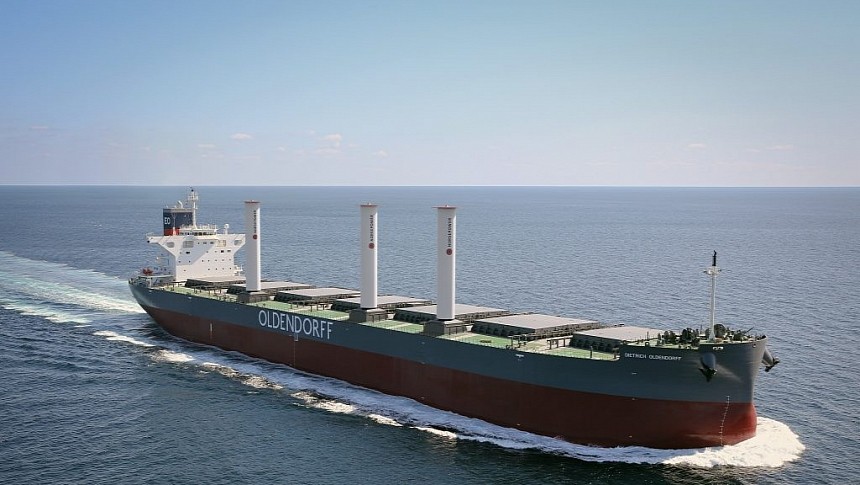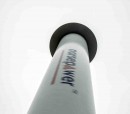The latest ship to be retrofitted with the state-of-the-art Norsepower Rotor Sails for cutting emissions is the Dietrich Oldendorff, a Post-Panamax (modern) bulk carrier operated by the German-based shipping operator Oldendorff.
Wind power, which is considered by many to be the purest source of energy available, is changing contemporary shipping in a big way. Numerous modern technologies are reinventing and upgrading the traditional art of sailing. Some of them, including the one developed by Norsepower, are improved versions of the classic Flettner rotor. Or, as the Finish maritime tech company puts it, they are "a digital-era version" of this rotor concept.
The IMO (International Maritime Organization) is determined to make emission-related regulations gradually harsher over the next decades, which is why most shipping operators have no choice but to look at solutions for cutting emissions that won't have a negative impact on the vessels' capacity and performance. Modern, state-of-the-art rotor sail technologies are an ideal alternative because they can be implemented on existing ships with great results.
Like most of today's sailing technologies, the Norsepower Rotor Sail is an automatic system comprised of sails (available at various heights), a control system for adjusting the forward thrust of the sails, a control panel for the captain, and a low-voltage electrical power supply. The cylindrical rotors installed on the deck use electric power to rotate. This rotation and the wind power combined create a much more powerful thrust compared to classic sailing. It's basically a fuel-saving solution that results in fewer emissions overall.
Automation is a huge leap from the original Flettner Rotor concept, which makes it possible to measure wind speed and direction at any given moment and adjust the thrust accordingly. This state-of-the-art system can use these measurements to assess whether the use of the Rotor Sails would reduce emissions at a particular time and automatically launch them. This increases the system's efficiency considerably.
What's even more interesting about the Norsepower Rotor Sail compared to other modern rotor sails is that, in addition to lowering emissions, it's also a sustainable alternative. The rotors themselves are partly made from plastic bottles (more than 340,000 bottles, according to the manufacturer). The Oldendorff vessel will be fitted with three 24 x 4 meters (78.7 x 13 feet) rotor sails.
This particular Rotor Sail is also a proven technology, with more than 310,000 operating hours under its belt onboard various ships. In the years since it started operating, this technology has helped cut more than 21,000 tons of CO2 emissions.
This cutting-edge technology isn't limited to bulk carriers and tankers. In 2022, the prestigious ferry operator Scandlines installed the Norsepower Rotor Sail on its hybrid M/F Berlin ferry operating between Germany and Denmark for further emission reduction.
The IMO (International Maritime Organization) is determined to make emission-related regulations gradually harsher over the next decades, which is why most shipping operators have no choice but to look at solutions for cutting emissions that won't have a negative impact on the vessels' capacity and performance. Modern, state-of-the-art rotor sail technologies are an ideal alternative because they can be implemented on existing ships with great results.
Like most of today's sailing technologies, the Norsepower Rotor Sail is an automatic system comprised of sails (available at various heights), a control system for adjusting the forward thrust of the sails, a control panel for the captain, and a low-voltage electrical power supply. The cylindrical rotors installed on the deck use electric power to rotate. This rotation and the wind power combined create a much more powerful thrust compared to classic sailing. It's basically a fuel-saving solution that results in fewer emissions overall.
Automation is a huge leap from the original Flettner Rotor concept, which makes it possible to measure wind speed and direction at any given moment and adjust the thrust accordingly. This state-of-the-art system can use these measurements to assess whether the use of the Rotor Sails would reduce emissions at a particular time and automatically launch them. This increases the system's efficiency considerably.
What's even more interesting about the Norsepower Rotor Sail compared to other modern rotor sails is that, in addition to lowering emissions, it's also a sustainable alternative. The rotors themselves are partly made from plastic bottles (more than 340,000 bottles, according to the manufacturer). The Oldendorff vessel will be fitted with three 24 x 4 meters (78.7 x 13 feet) rotor sails.
This particular Rotor Sail is also a proven technology, with more than 310,000 operating hours under its belt onboard various ships. In the years since it started operating, this technology has helped cut more than 21,000 tons of CO2 emissions.
This cutting-edge technology isn't limited to bulk carriers and tankers. In 2022, the prestigious ferry operator Scandlines installed the Norsepower Rotor Sail on its hybrid M/F Berlin ferry operating between Germany and Denmark for further emission reduction.







